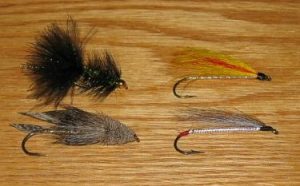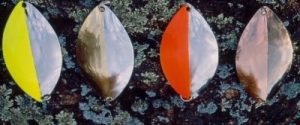Spring Rainbows on Trolled Streamers
(dans ONTARIO Fishing Network – 2004)
A rainbow fooled by a woolly bugger
Mid to late April is when ice often leaves Ontario lakes, unveiling open water trout fishing. I particularly enjoy targeting rainbow on small lakes at this time of year. Fishing tactics in the spring include casting or trolling small spoons, minnow plugs, or streamer flies. It’s the latter that has consistently delivered for me over the years, and you don’t need a fly rod to fish them.
The Spring Thaw
It’s no secret that trout seek cool water rich in oxygen. In the scorching days of summer this preference is what causes trout to go deep, but during spring trout are often close to the surface and quite active. The cool temperatures of an early spring lake meet the rainbow’s oxygen and temperature needs. The longer days, and the warmer sun, of spring speeds up the metabolism of the lake’s residents, causing trout to begin actively, and aggressively, feeding on available forage.
Often the side of the lake, and its structure, that receives the most sun where fishing is the most productive just after ice out. These slightly warmer areas attract, or awaken, small organisms, aquatic invertebrates and insects, and baitfish – a buffet for hungry trout. It’s not a rarity when fishing to see several trout rising or jumping on the surface as they feed in these areas.
Trolling
I prefer to troll streamers from either a canoe or a rowboat. The propulsion-and-pause movement of these boats translates directly into the action of the fly, giving it an irresistible action. Using a trolling motor is another method to troll wet flies. Whatever you use, stealth is paramount as trout spook easily in shallow water.
It’s wise to troll for trout with long lines (50 to 75 feet is not uncommon). Areas to troll include: breaklines, shoals and bays. Troll in large S-turns when working these structures to cover different water depths. Also, don’t be afraid to lift your rod and twitch it every so often; doing this causes the fly to shoot up with each twitch and then fall. Many hits come as the fly falls so wait a few seconds before you start trolling again.
Here is an assortment of streamers
Pictured left to right are, woolly bugger and mickey finn (top), muddler minnow and black nose dace (bottom).
Flies and Trolling Set-Up
Picking streamers for the first time can seem overwhelming, but here’s a listing of some tried and true flies: black nose dace, mickey finn, muddler minnow, and woolly bugger. Flies come in varying sizes, colours and patterns. Ask your local tackle shop what’s working. Dark, natural colours, like greens, browns, grays and blacks, are great in clear lakes. Also, try to have a selection of weighted and unweighted flies to help you fish different depths. A personal favourite is a black or olive, bead head woolly bugger. When trolling flies, experiment with different sizes. Small minnow flies, like a black nose dace, may match-the-hatch to spring minnow size, but don’t be afraid to try a larger streamer, like a woolly bugger, as these sized flies can also fool trout.
If trolling with a spinning combo you can add flash in front of your fly. To do this, either modify a spoon, removing the treble hook or use a small flasher, like Lucky Strike’s Silver Lake Wobbler. Next, attach two swivels to each end of the flasher to prevent line twist. Then, tie the fly to a two to three foot leader at one swivel and the main line to the other end. You may also need to add some split shot weights to compensate for the wobbler’s lift.
Using wobblers, like Lucky Strike’s Silver Lake pictured here, will add flash to your presentation when trolling.
Tackle and Gear
You can use either a spinning or a fly rod to troll streamer flies. A light to medium action spinning rod with four to six pound-test will allow you to properly present these flies. A fly rod that can handle five to six weight line is another set-up. With fly rods you can use either floating or sinking line. I use 3X to 4X leaders for trolling and tie tippet on to increase their length to about ten feet. You can also get by with straight, monofilament as a leader since you don’t require a taper if you’re not casting flies.
Rod holders can also be handy when trolling, as big bows can pull line fast. The downside to rod holders is you loose the sensitivity you would have if holding your rod. Anglers are also less likely to impart action, like lifting or jigging, into the rod if it’s in a holder. Sometimes, these little additions are required to get a following trout to strike.
Experiencing spring rainbow fishing is a great way to get over cabin fever. If you can locate trout, quietly trolling wet flies will definitely get you into some rod bending action. Give this method a try this spring to start your 2004 open water season with success.


